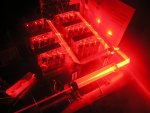I understand that when using a polarized beamsplitter/combiner cube to combine two same-color beams, that one of the beams must be oriented one way, the other beam 90 degrees to that. The resultant beam, I would guess, then has both H and V polarized components, yes? If so, how does one cascade beam combiners? I have an image posted below of such an array - I need to know where this image came from (this was posted SOMEWHERE on LPF, but I cannot find the original post) and how it is done - because this is exactly what I am doing, only on a smaller scale. THANKS for the info!
Dave
Dave




